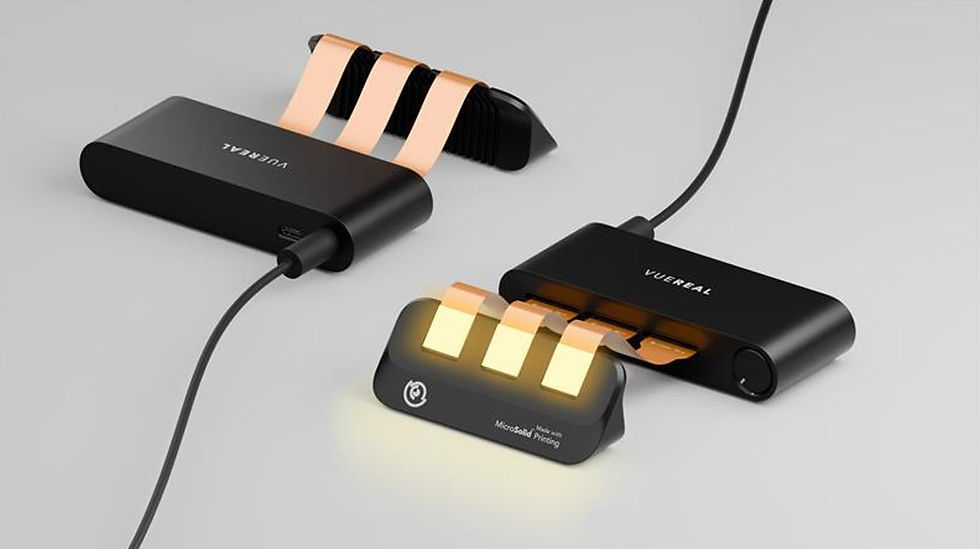VueReal | Unlocking MicroLED’s Potential: Why Reference Design Kits Are the Key to Mass Adoption
- khashayar Ghaffarzadeh

- Aug 7
- 4 min read
Brad Martin, VueReal | bmartin@vuereal.com
MicroLEDs promise to reshape the future of displays and lighting - with higher brightness, lower power consumption, and longer lifespans than OLEDs. But for most innovators, that promise has remained just out of reach. Not due to lack of ideas or demand, but because of one persistent barrier: access.
That’s now starting to change, thanks to the arrival of Reference Design Kits (RDKs): pre-integrated microLED modules that empower engineers, designers, and developers to prototype and experiment - without custom fabrication, high-volume commitments, or massive investment. By dramatically lowering the barrier to entry and leveraging flexible manufacturing methods, RDKs are unlocking a new era of innovation - accelerating both the pace of discovery and the path to mass adoption.

The Real Bottleneck: Access, Not Imagination
Unlike OLED panels - which are widely available for prototyping and development - microLEDs have historically been locked behind technical and supply chain hurdles. Most companies simply can’t get their hands on the technology. Traditional microLED manufacturing typically requires highly specialized equipment, high-volume commitments, and extensive engineering integration, putting it out of reach for the majority of companies.
Even those who want to explore microLEDs in earnest are left to imagine what is possible rather than test, iterate, and build. This creates a fundamental mismatch between the potential of microLED and the ability of teams to work with it.
A Shift Toward Flexible Manufacturing
That dynamic is now beginning to change. Advances in high-precision transfer technologies - such as MicroSolid Printing - have introduced a new manufacturing model, one that supports high, medium, and low volume production without the need for dedicated fabrication facilities. With these processes, microLED modules can be produced flexibly, whether for single prototypes, pilot runs, or limited product lines. The result is lower capital expenditure, faster iteration, and greater accessibility for engineering and product teams of all sizes. Crucially, this unlocks the ability to offer microLED technology as a modular, off-the-shelf component: the Reference Design Kit.
Reference Design Kits: The Bridge Between Promise and Product
RDKs mark a major shift in how companies interact with microLED technology. Rather than needing to co-develop complex custom solutions from scratch, product teams can now acquire pre-built modules - complete with drive electronics, integration documentation, and support - to start experimenting immediately.
These kits serve two essential purposes:
Proof of Feasibility: RDKs demonstrate that microLED mass transfer and integration are not just theoretical - they’re commercially viable today.
Platform for Innovation: RDKs empower teams to explore use cases, iterate quickly, and build proofs of concept in-house without large development contracts or IP entanglements.

Bringing the Ecosystem to Life
The arrival of accessible RDKs is catalyzing a new wave of ecosystem development across the semiconductor and display industries. OEMs, integrators, and supply chain partners can now collaborate on real prototypes, share feedback, and accelerate the learning curve for microLED integration. This collaborative environment not only speeds up product development but also helps establish new standards, best practices, and supply relationships - reshaping the value chain for next-generation displays and lighting.
From “What If” to “What’s Next”
Until recently, microLED Reference Design Kits (RDKs) simply did not exist. Now, with the first commercially available kits on the market, engineers and designers finally have a way to experiment with real, working microLED modules.
The result: immediate momentum across a wide range of industries. Among the concepts generating early excitement:
Ultra-Thin Automotive Lighting: Sleek, bright taillights and signal indicators that offer new levels of design flexibility.
Transparent Steering Wheel or Windshield Displays: See-through displays that deliver information without obstructing a driver’s view.
Advanced Puddle Lighting and Side-Mirror Signals: Compact, high-brightness modules that open the door to new safety and communication features.
AR/VR Microdisplays: Ultra-bright, high-resolution microdisplays for next-generation headsets.
Laminated Glass Displays: Embedded microLEDs within structural glass for automotive, architectural, and other applications.

These are just a few of the applications already under exploration. The real power of RDKs lies in the countless other ideas they will unlock - many of which will emerge once developers can experiment directly, without barriers.
To capitalize on this shift, forward-looking companies should:
Foster Cross-Functional Exploration: Bring together hardware, UX, and product teams to brainstorm and prototype with RDKs.
Embrace Rapid Iteration: Use RDKs to test ideas early and often, accelerating learning and reducing development risk.
Codevelop with your RDK Manufacturer: Offer feedback, request features, and participate in the co-creation of future modules and form factors.
The Road Ahead
The mass adoption of microLEDs is no longer a distant promise. With RDKs enabled by flexible, fab-free manufacturing models, access is now democratized. The technology is moving out of the lab and into the hands of the innovators who will shape its future. This ecosystem-driven approach will not only accelerate product launches but also foster new collaborations and standards across the industry.
As microLED technology becomes truly accessible, expect a radical transformation in how displays and lighting are conceived and delivered across markets.
Sidebar: What is MicroSolid Printing?
MicroSolid Printing is a high-precision, additive mass transfer process that enables the rapid and flexible assembly of microLED arrays onto a variety of substrates. Unlike traditional methods that require dedicated fabrication facilities and high-volume runs, MicroSolid Printing also supports low- to medium-volume production - allowing manufacturers to deliver microLED modules in any quantity, from single prototypes to pilot runs. This process dramatically lowers capital expenditure and accelerates product development cycles, making microLED technology accessible to a much broader range of innovators.






Comments